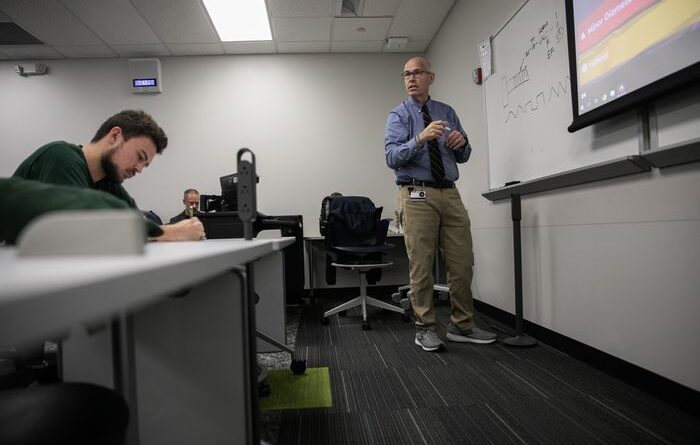Different Type of Manufacturing
U.S. manufacturers have long struggled to find all the employees they need. The coming wave of megafactories, aided by billions of dollars in public incentives, could push the shortage into a crisis, executives and industry officials say. The anxiety is particularly acute in Central Ohio, where Intel is building two semiconductor plants at a combined cost of more than $20 billion, and Honda and LG Energy Solution are constructing a $3.5 billion electric-vehicle battery plant. The companies aim to hire more than 5,000 workers between them, and local suppliers that will serve the factories likely will need thousands more.
That leaves smaller manufacturers bracing for an intensifying labor battle.
“Workforce is the No. 1 problem anywhere we go in Ohio, and it’s more so in Central Ohio,” said Ryan Augsburger, president of the Ohio Manufacturers’ Association. “It’s going to get a lot worse with large companies like Intel.”
Building Boom
The U.S. is experiencing a factory-building boom as companies, burned by overstretched supply chains during the pandemic, reshore some of their operations. The Biden administration also has given priority to the nation’s semiconductor and EV industries, calling them matters of national security and setting aside billions of dollars in subsidies to aid their growth.
The value of new manufacturing construction projects hit a record $102 billion last year, three times higher than 2019’s total, according to Richard Branch, chief economist of the Dodge Construction Network. Since 2021, 33 manufacturing projects, most of them related to semiconductors or electric vehicles, have cost $1 billion or more.
Intel last year picked a site 20 miles northeast of downtown Columbus as the location for its first new semiconductor complex in 40 years. The two plants, known as fabs, are among 37 new or expanding chip-manufacturing facilities announced in the U.S. after the 2020 introduction of legislation that became the $53 billion Chips and Science Act.
Semiconductor Industry
The Semiconductor Industry Association warns that the building boom could come with a labor shortage. More than half of the roughly 115,000 new positions expected to be created by the end of the decade could go unfilled, the group projects.
Intel aims to be an exception. Cindi Harper, the company’s vice president of talent planning and acquisition, said it has experience building workforces at its facilities in Oregon, New Mexico and Arizona, and is following a similar playbook in Ohio.
Intel has helped to design a training curriculum that will be offered at Ohio’s community colleges. The program, which in some cases can be completed in a year at a cost of about $3,700 before financial aid, familiarizes students with semiconductor manufacturing so they can become technicians, an entry-level job that involves maintaining and troubleshooting equipment at the highly automated plants.
The initial cohort of seven men and one woman began this fall at Columbus State Community College. The class includes Forest Colegrove, a 27-year-old professional caregiver who shook off bad experiences with previous factory jobs to enroll in the program.
“This is a different type of manufacturing,” he said. “This is super-educated, specially trained. There’s a lot on the line for this type of work.”
Honda, which already has four plants in Central Ohio, is talking to community college presidents, public school administrators and workforce development officials to develop pathways to its EV joint venture, a spokesman said.
Columbus State Pathway
Representatives of both companies came to Columbus State in October for a manufacturing career day aimed at high-school students. A Honda employee who had studied at the college talked about the automaker’s advanced technology, while Intel brought virtual-reality goggles that let the teens visualize what it’s like to work in a fab.
Deeksa Kasirajan, a 17-year-old senior at Dublin Scioto High School, joined a crowd around Intel’s booth. She had come to the career day to learn about manufacturing but heard nothing to shake her plan of becoming a biomedical engineer.
“I’m more interested in something that’s more innovative and not repetitive,” she said.
Source: Different Type of Manufacturing
https://www.wsj.com/business/factory-manufacturing-jobs-tough-to-fill-workers-cd4b48da?st=clnnz8ncikq9v7o&reflink=article_imessage_share
The Megafactories Are Coming. Now the Hustle Is On to Find Workers
Semiconductor and EV plants in Central Ohio search for employees amid manufacturing labor shortage; smaller factories brace for tougher competition
COLUMBUS, Ohio—Enormous factories are sprouting outside of this capital city. Now comes the hard part—finding people to work in them.
Manufacturing jobs are tough to fill around Columbus, which has one of Ohio’s lowest unemployment rates and a flourishing logistics industry that competes for the same employees. The region’s plants have thousands of open positions, a shortage that is causing some managers to join their workers on the production line.
https://www.techedmagazine.com/category/news-by-industry/manufacturing-education/

